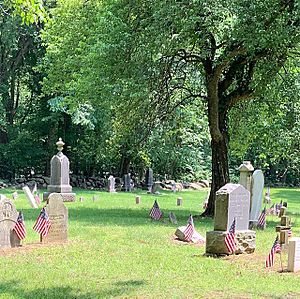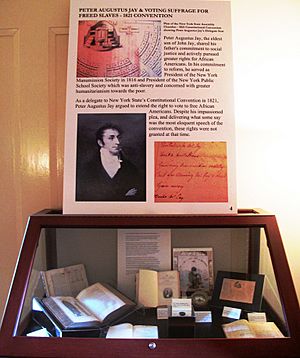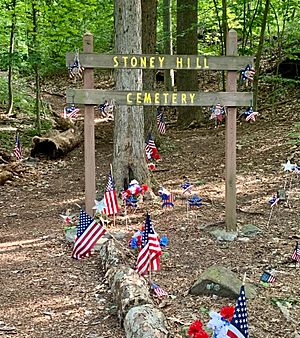African American Heritage Trail of Westchester County facts for kids
The African American Heritage Trail of Westchester County in New York was created in 2004. Its goal is to protect and share the stories of African American men and women. These individuals made important contributions to American history. Westchester County historian Larry Spruill led the research for this project.
Contents
- Discovering Black History in Westchester
- Important Places on the Trail
- Saint Paul's Church National Historic Site
- Jay Estate: A Place of Freedom
- John Jay Homestead: Jay's Retirement Home
- Rye African-American Cemetery
- Foster Memorial AME Zion Church
- Stony Hill Cemetery: A Quaker Gift
- Philipsburg Manor: Lives of the Enslaved
- Monument to the First Rhode Island Regiment
- Ella Fitzgerald Statue: A Jazz Legend
- Jack Peterson Memorial: A Revolutionary Hero
- Villa Lewaro: Madame C. J. Walker's Home
- See Also
Discovering Black History in Westchester
The African American Heritage Trail was started by the African American Advisory Board of Westchester County (AAAB). Barbara Edwards currently leads this board. The AAAB hosts events like the annual Trailblazer Awards. These events and other programs take place at several of the 14 sites along the trail.
Important Places on the Trail
As of 2020, the trail includes 14 special heritage sites. Each site helps tell a part of the story of African Americans in Westchester.
Saint Paul's Church National Historic Site
This landmark is in Mount Vernon, New York. It is managed by the National Park Service. Thousands of African American men and women are buried here. Programs at the church highlight the contributions of both enslaved and free families. These families lived in the community near Eastchester Creek. Church records can also help with family history research.
Jay Estate: A Place of Freedom
The Jay Estate is in Rye, New York. It was the home of John Jay and his family. Enslaved and freed African Americans also lived here. School tours and programs focus on how slavery ended in New York. They also teach about Civil Rights. John Jay worked against slavery. He helped create the NY Manumission Society. He also helped pass New York's Gradual Emancipation Act. This law slowly ended slavery in the state. Educational programs share the lives of enslaved people who lived at "The Locusts." These include Caesar Valentine, Mary, and Clarinda. Some are buried in unmarked graves on the property. The non-profit Jay Heritage Center runs this 23-acre park.
John Jay Homestead: Jay's Retirement Home
The John Jay Homestead is in Katonah, New York. This was John Jay's home after he retired. New York State Parks owns this site.
Rye African-American Cemetery
The Rye African-American Cemetery is in Rye, New York. It was added to the National Historic Register in 1860. At least 300 people are buried here. This includes African American veterans of the Civil War. The non-profit Friends of the Rye African American Cemetery maintains it. Programs and a large display trace the lives of free African Americans. These individuals lived and worked in Rye, Mamaroneck, and Scarsdale. They include the Purdy, Brown, and Petersen families. The site holds annual events on Memorial Day and Veterans Day.
Foster Memorial AME Zion Church
This church is in Tarrytown, New York. The Foster Memorial AME Zion Church was a safe place for enslaved people who had escaped.
Stony Hill Cemetery: A Quaker Gift
Stony Hill Cemetery is an 18th-century burial ground in Harrison, New York. Over 200 free Black residents from "The Hills" of Harrison are buried here. This includes a dozen African American Civil War veterans. The Quaker Church originally gave this land to freed enslaved people. This property is connected to the Mount Hope African American Zion Church.
Philipsburg Manor: Lives of the Enslaved
Philipsburg Manor is in Sleepy Hollow, New York. Over 23 enslaved men and women lived at this manor. They were owned by the Philipse family. The site hosts programs that show the humanity of these individuals. They were treated as property, but they were real people. Historic Hudson Valley owns and operates this site.
Monument to the First Rhode Island Regiment
This monument is in Yorktown Heights, New York. It honors soldiers of the First Rhode Island Regiment. They died in the Battle of Pine's Bridge during the Revolutionary War. Many of these soldiers were enslaved African Americans. Historian John H. Harmon helped put up this stone in 1982. It stands in front of the First Presbyterian Church of Yorktown Heights.
Ella Fitzgerald Statue: A Jazz Legend
The Ella Fitzgerald Statue is in Yonkers, New York. Ella Fitzgerald was a famous jazz singer. She grew up in Westchester. African American artist Vinny Bagwell created this statue. It celebrates her amazing contributions to American music.
Jack Peterson Memorial: A Revolutionary Hero
The Jack Peterson Memorial is in Croton, New York. It is named for John Jacob "Rifle Jack" Peterson. He was a hero in the Revolutionary War. Peterson's brave act helped lead to the capture of Major Andre. This was a very important moment in the war.
Villa Lewaro: Madame C. J. Walker's Home
Villa Lewaro is in Irvington, New York. This historic house belonged to Madame C. J. Walker. She was an African American businesswoman and a pioneer in cosmetics. This home is privately owned and not open to the public.
See Also






